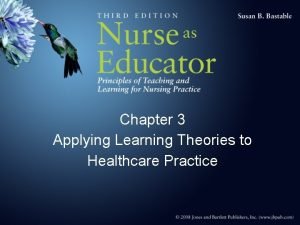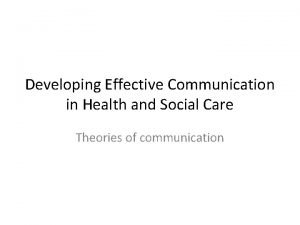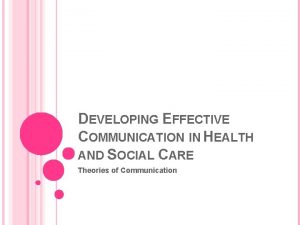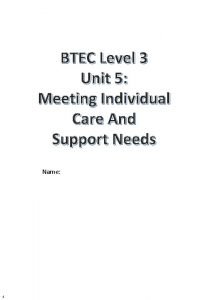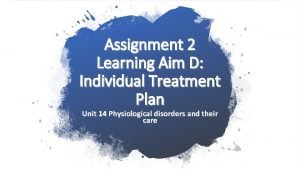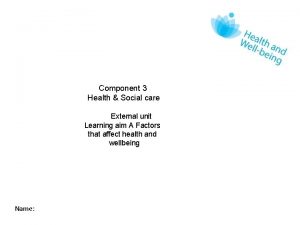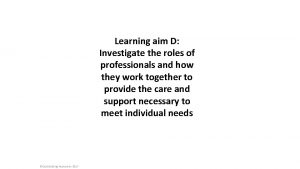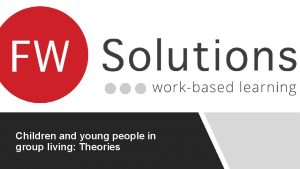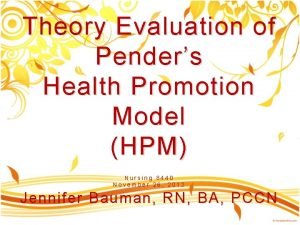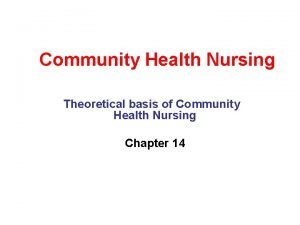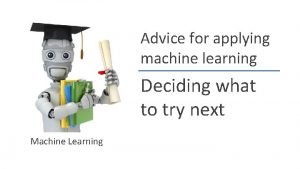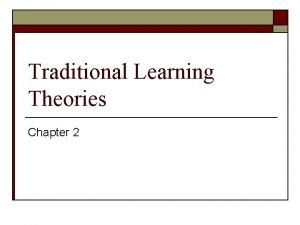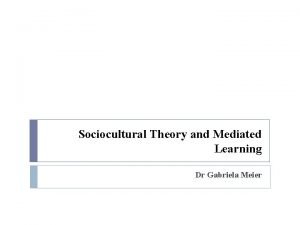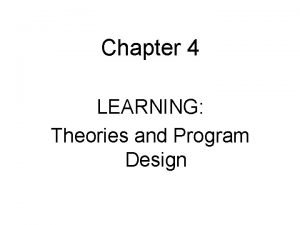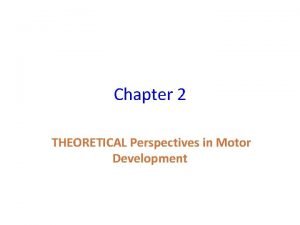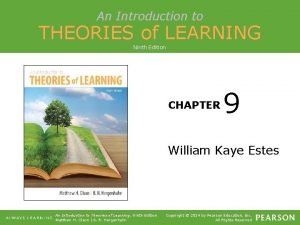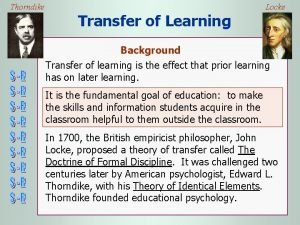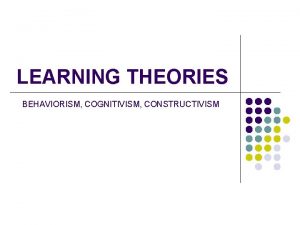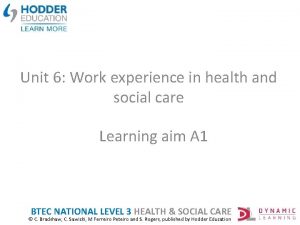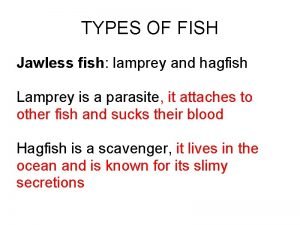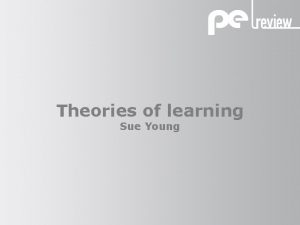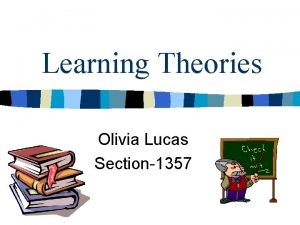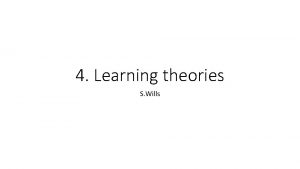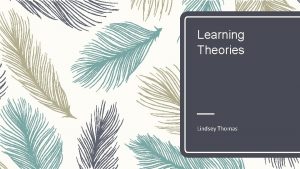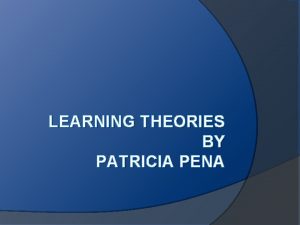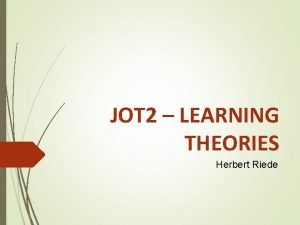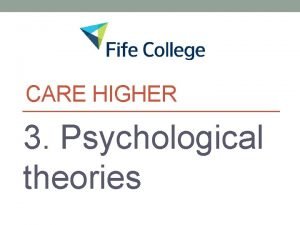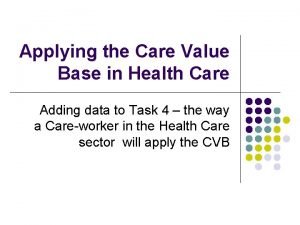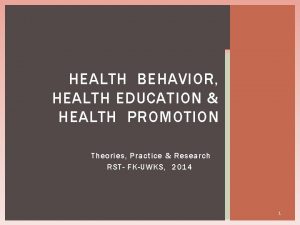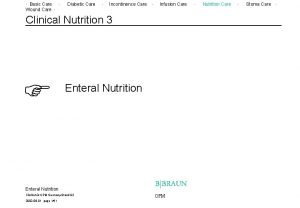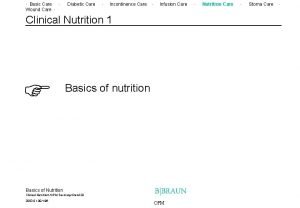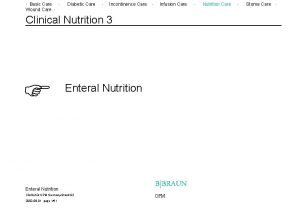Applying Learning Theories to Health Care Applying learning















































- Slides: 47

Applying Learning Theories to Health Care

Applying learning theories to health education 1. 2. 3. 4. 5. Behaviorist learning theories Cognitive theory Social theory Psychodynamic theory Humanistic theory

1. Behaviorist learning theory • Learning is the result of connections made between the stimulus conditions in the environment (S) and the individual’s responses (R)—Sometimes termed S-R model of learning. • Approaches the study of learning by focusing on behaviors that can be observed , measured, and changed. • To encourage people to learn new information or to change their attitudes and responses, behaviorists recommend altering conditions in the environment and reinforcing positive behaviors after they occur.

… Behaviorist learning theory • Two ways to change behavior and encourage learning using behaviorist principles 1 - respondent conditioning 2 - operant conditioning

… Behaviorist learning theory 1 - Respondent conditioning • Emphasizes the importance of stimulus conditions in the environment and the associations formed in the learning process. 2 - Operant conditioning • Focuses on the behavior of the individual and the reinforcement that occurs after the response.

Learning or conditioning is quite simple: • A neutral stimulus (NS) has no particular meaning or value to the learner is paired with Naturally occurring unconditioned or unlearned stimulus (UCS) and Unconditioned response (UCR) NS+ UCS UCR • After a few such pairings the neutral stimulus alone without the unconditioned stimulus will produce the same response NS UCR • Without thought or awareness learning occurs when the newly conditioned stimulus (CS) becomes associated with conditioned response(CR) CS CR

1 - Respondent conditioning Example: someone without experience in hospital---(NS) Visit sick pt. …. . smell odors---(UCS) that make him feel queasy (nauseous) and light headed---(UCR) After his first visit, his subsequent visit to hospital—(CS) become associated with feeling anxious and nauseated—(CR) Especially if the visitor smells odors similar to those encountered during the first experience.

Ivan Pavlov 8

… Behavioral Learning Theories 9

1 - Principle of Respondent conditioning • May provide the basis for long-lasting attitudes toward medicine, healthcare facilities, and health professionals. • Used to get rid of or extinguish (switch off) a previously learned response, which has been found to be especially useful in teaching people to reduce their anxiety or break bad habits. • Teacher encourage the learner to build new associations for learning. • In health care, respondent conditioning has been used to treat addiction, phobias, and tension

2 - Operant conditioning • To increase learning, is to apply positive reinforcement or rewards after the behavior occurs. • To decrease a bad habits, is accomplished by using either nonreinforcement or punishment. • If nonreinforcement does not work, then punishment may be employed as way to decrease responses. • There a risks to use punishment—learner may become so emotionally upset (ashamed, sad, or angry). • To be effective, it is necessary to assess what kinds of reinforcement are likely to increase or decrease the behaviors to each individual.

2 - Operant conditioning- cont. • Operant conditioning has been found to work well with nursing home and long-term care residents • and with patients who are not very verbal or do not engage in much thought or reflection • The success of operant conditioning partially depends on when the enforcement is applied. In early stages learning needs to be reinforced every time it occurs

Operant Conditioning- cont. • Learning occurs as the organism Responds to S- stimuli in the environment and is reinforced for making a particular response. • A REINFORCER is applied after a Response strengthens the probability that the response will be performed again under similar conditions. 13

Example of Positive Reinforcement (PR) -We may continue to go to work each day because we receive a paycheck on a weekly or monthly basis. - If we receive awards for writing short stories, we may be more likely to increase the frequency of writing short stories.

Behaviorist learning theory • The basic principles of behaviorist learning are summarized as follows: • 1 - Focus on the learner’s drives, the external factors in the environment that influence a learner’s associations, and on reinforcements that increase or decrease responses.

Behaviorist theory (cont…) • 2 - The teacher’s task is first to assess conditions in the environment that lead to specific responses, the learner’s past habits and history of S-R connections, and what is reinforcing for a learner. • Then teachers must effectively manipulate conditions to build new associations, provide appropriate reinforcement, and allow for practice to strengthen connections between stimuli in the environment and a person’s responses or behavior.

2. The Cognitive Theory Jean Piaget Swiss Psychologist (1896 -1980) Cognition is: The mental activities involved in thinking, knowing, & remembering

… Cognitive Learning Theory • In contrast to behaviorist theory, cognitive theory focuses on what goes on “inside” the learner. Especially learners’: o Perception o Thought o Memory and o Ways of processing and o Structuring information According to this perspective for individual to learn, they must change their perception and thoughts and form a new understanding and insights.

Cognitive Learning Theory: • Cognitive theorists , unlike behaviorists, maintain that reward is not necessary for learning. • More important are learners’ goals and expectations, which create disequilibrium, imbalance, and tension that motivate them to act. 19

Cognitive Theory cont…. . • Learning involves perceiving the information, interpretation, and reorganizing information into new insights. • The individuals’ goals and expectations are the sources of motivation that create disequilibrium, imbalance, tension and the desire to learn. • In order for the transfer of learning to happen, the leaner must mediate, or act on the learning

The Cognitive Theory • Piaget was interested in how the mind works and organizes information. • He believed that mental development is an orderly, sequential process that begins the day the infant is born. This process is same for all people but the rate of progression is different. • Cognitive development is an interactive process in which a variety of new experiences must exist before intellectual abilities can develop.

Cognitive learning theory- Approaches to learning Within the cognitive theory several approaches to learning such as: • Gestalt perspective: persons perceives interprets and response to any situation in his or her own way • Cognitive development ***** • Information processing ***** • Social cognition: focused on the effect of social cultural factors on perception thoughts and motivation

The Cognitive Development • According to Piaget there are four sequential stages of Cognitive development : A. The Sensorimotor Stage B. The Preoperational Stage C. The Concrete Operations Stage D. The formal operations stage

A. The sensorimotor stage: • During infancy where infants explore their environment and attempts to coordinate sensory information with motor skills

B. The preoperational stage During early childhood where youngsters are able to: • mentally represent the environment • regard the world from their own egocentric (self centered) perspective and • come to grips with symbolization

C. the concrete operations stage • The concrete operation stage during elementary school years where children are able to attend to more than one dimension at a time conceptualize relationships and operate on the environment.

D. The formal operations stage • During adolescence where teenagers begin to think abstractly (theoretically), are able to deal with the future and can see alternatives and criticize

Information-Processing Perspective: • The way individuals perceive, process, store, and retrieve information from experiences determines how learning occurs and what is learned. • Organizing information and making it meaningful aids the attention and storage process; learning occurs through guidance, feedback, and assessing and correcting errors. • eg. Next pg……………. . 28

Information processing Stages of information processing: • Attention • Sensory processing: using one or more of the senses • Short term memory storage • Long term memory storage • Action response

Cognitive learning theory Principles of cognitive learning theory: • Focus on internal factors within learners, such as their developmental stage of reasoning, perceptions, thoughts, ways of processing and storing information in memory, and the influence of social factors on attitudes, thoughts, and actions • The role of the teacher is to assess learner’s developmental stage, goal & expectations, preferred style, then organize learning experience to be meaningful and keep learning simple and at appropriate level

3. social learning theory • Learning is often a social process, and other individuals, especially “significant others, ” provide compelling examples or role models for how to think, feel, and act. 31

… Social Learning Theory 32

… Social learning theory • Role modeling is the central concept of theory • Social learning theory can be considered a bridge or a transition between behaviorist learning theories and cognitive learning theories. • Behaviorists say that learning has to be represented by a permanent change in behavior,

… Social learning theory • Principles of social learning theory: • 1 - Focus on role model, the reinforcement that a model has received, the social environment and the four self regulating processes within the learner • 2 - The role of the teacher is to act as a typical role model, to use effective role models in teaching that are rewarded for their behavior, to assess the internal self-regulation of the learner, to provide feedback for learner’s performance

… Social Learning Theory • Much of the learning occurs by observation, watching others and learning what happens with them. • Social learning theory focuses on the learning that occurs within a social context. It considers that people learn from one another, including such concepts as observational learning, imitation, and modeling.

… Social Learning Theory • Albert Bandura is considered the leading proponent of this theory. He outlined a four-step, largely internal process that directs social learning. the behaviorist and cognitive dimensions of theory

… Bandura’s principles (1977) There are four steps, which are internal processes that direct social learning • 1. Attention phase: attention to role models that are high status. • 2. Retention phase: the storage and retrieval of what was observed. • 3. Reproduction phase: learner copies the observed behavior. • 4. Motivation phase: whether the learner is motivated to perform the learned behavior.

4. Psychodynamic theory Principles of the Psychodynamic theory • 1 - Focus on learner’s personality development, significant childhood experiences, conscious and unconscious motivations, id(social values and standards taught)ego(self) –superego(integrity, morality) conflicts and defensive behaviors • 2 - The teacher’s role is to listen, ask probing questions about motivations and wishes, assess emotional barriers to learning, and make learning pleasurable while working to promote ego strength in learners

5. Humanistic theory • The assumptions that each individual is unique and that all individuals have a desire to grow in positive way • According to humanistic, feeling and emotions are the keys to learning, communication, and understanding.

… Humanistic Learning Theories • Learning occurs on the basis of a person’s motivation, derived from needs, the desire to grow in positive ways, self-concept, and subjective feelings. • Learning is facilitated by caring facilitators and a nurturing environment that encourage spontaneity, creativity, emotional expression, and positive choices 40

… Humanistic theory • One of the best-known humanistic theorist is Abraham Maslow


… Humanistic theory Principles of learning: • 1 - Focus on the learner’s desire for positive growth, subjective feelings, needs, self- concept, choices in life, and interpersonal relation ships • 2 - The teacher’s role is to assess and encourage changes in learner’s concept, and feelings by providing support, freedom to choose, and opportunities for creativity

Experiences that affect learning • Educator must be knowledgeable • Learner’s past experience • Lack of clarity and meaningfulness on what is to be learned, neglect, poor role models, confusing reinforcement, inappropriate materials for learner’s ability.

To ensure learning is permanent • • • Organize the learning experience Make it meaningful Pace the presentations Practicing new information Reinforcement Assess and evaluate learning

Learning theories Figure

Application of learning theories • Each theory emphasis certain aspects of learning • We can use one or a combination of more than one • Behaviorists focus on stimulus conditions and pay attention to reinforcement, manipulating environment, • Social learning theory stresses role models that would demonstrate the behavior • use theory according the type of the learner, a passive learner might benefit more from a behaviorist approach.
 Applying learning theories to healthcare practice
Applying learning theories to healthcare practice Humanistic theories examples
Humanistic theories examples Communication groups
Communication groups Theories of communication in health and social care
Theories of communication in health and social care Levels of nursing care primary secondary tertiary
Levels of nursing care primary secondary tertiary Health and social care values unit 2
Health and social care values unit 2 Health and social care component 3 health and wellbeing
Health and social care component 3 health and wellbeing Hcp lan apm framework
Hcp lan apm framework Health and social care unit 5 learning aim d
Health and social care unit 5 learning aim d Unit 14 learning aim d health and social care
Unit 14 learning aim d health and social care Health and social care component 2 learning aim b example
Health and social care component 2 learning aim b example Learning aim d health and social care
Learning aim d health and social care Group living theories
Group living theories Nola pender health promotion model
Nola pender health promotion model Public health nursing principles
Public health nursing principles Advice for applying machine learning
Advice for applying machine learning Traditional learning theories
Traditional learning theories Sociocultural theories of learning
Sociocultural theories of learning Learning theories and program design
Learning theories and program design Dynamical systems theory motor development
Dynamical systems theory motor development An introduction to theories of learning
An introduction to theories of learning Thorndike
Thorndike Differentiated learning theories
Differentiated learning theories Behaviorism theory
Behaviorism theory Cuadro comparativo de e-learning b-learning y m-learning
Cuadro comparativo de e-learning b-learning y m-learning Duty of care care certificate
Duty of care care certificate Magneti artificiali
Magneti artificiali Palliative care versus hospice care
Palliative care versus hospice care Animalele se inmultesc prin
Animalele se inmultesc prin Care sunt simturile prin care sunt evocate
Care sunt simturile prin care sunt evocate Care certificate standard 10
Care certificate standard 10 Hip fracture care clinical care standard
Hip fracture care clinical care standard West yorkshire and harrogate health and care partnership
West yorkshire and harrogate health and care partnership Lamprey phylum
Lamprey phylum Btec health and social care level 3 unit 6: work experience
Btec health and social care level 3 unit 6: work experience Health and social care unit 2
Health and social care unit 2 Health and social care unit 2
Health and social care unit 2 Physiological disorders health and social care
Physiological disorders health and social care How do hagfish feed
How do hagfish feed Uccs health circle primary care clinic
Uccs health circle primary care clinic Lamprey health care
Lamprey health care Australian primary health care research institute
Australian primary health care research institute Makalah pelayanan kesehatan primer
Makalah pelayanan kesehatan primer Dr. kanupriya chaturvedi
Dr. kanupriya chaturvedi Principles of primary health care
Principles of primary health care Defination of phc
Defination of phc Concepts of primary health care
Concepts of primary health care Pearson btec health and social care level 3
Pearson btec health and social care level 3
